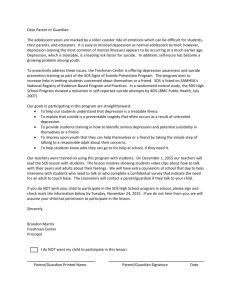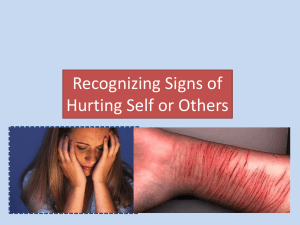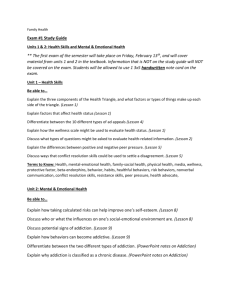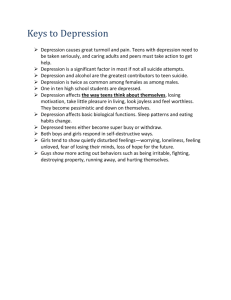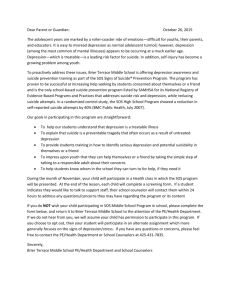Depression / Suicide / Self-Injury / Addiction
advertisement
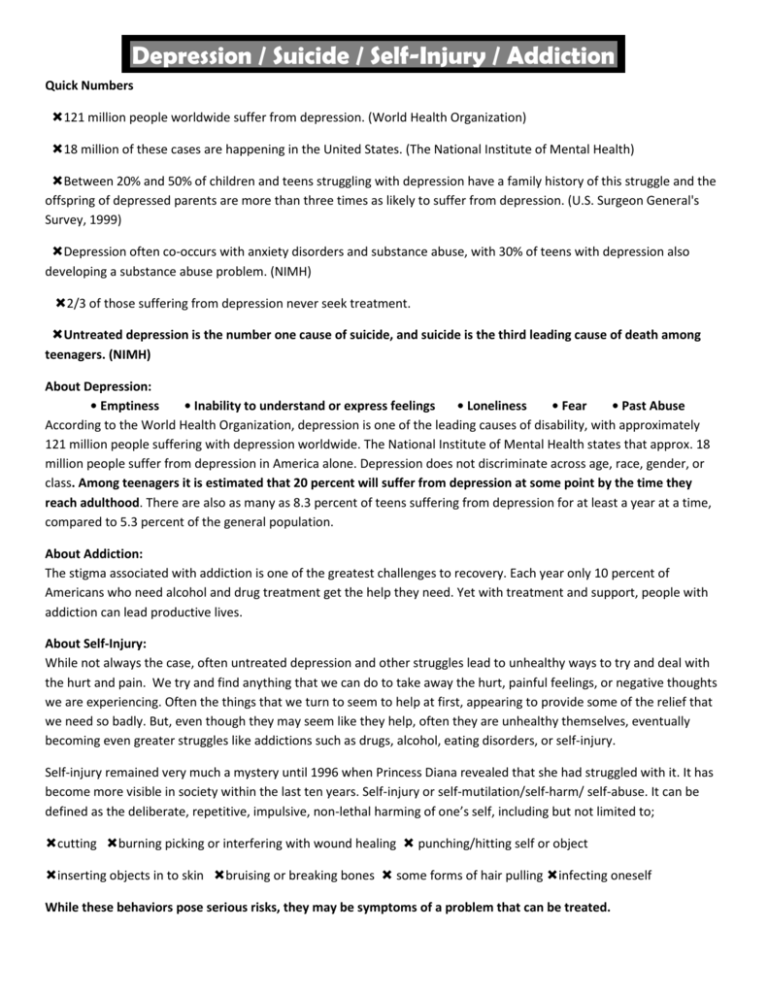
Depression / Suicide / Self-Injury / Addiction Quick Numbers 121 million people worldwide suffer from depression. (World Health Organization) 18 million of these cases are happening in the United States. (The National Institute of Mental Health) Between 20% and 50% of children and teens struggling with depression have a family history of this struggle and the offspring of depressed parents are more than three times as likely to suffer from depression. (U.S. Surgeon General's Survey, 1999) Depression often co-occurs with anxiety disorders and substance abuse, with 30% of teens with depression also developing a substance abuse problem. (NIMH) 2/3 of those suffering from depression never seek treatment. Untreated depression is the number one cause of suicide, and suicide is the third leading cause of death among teenagers. (NIMH) About Depression: • Emptiness • Inability to understand or express feelings • Loneliness • Fear • Past Abuse According to the World Health Organization, depression is one of the leading causes of disability, with approximately 121 million people suffering with depression worldwide. The National Institute of Mental Health states that approx. 18 million people suffer from depression in America alone. Depression does not discriminate across age, race, gender, or class. Among teenagers it is estimated that 20 percent will suffer from depression at some point by the time they reach adulthood. There are also as many as 8.3 percent of teens suffering from depression for at least a year at a time, compared to 5.3 percent of the general population. About Addiction: The stigma associated with addiction is one of the greatest challenges to recovery. Each year only 10 percent of Americans who need alcohol and drug treatment get the help they need. Yet with treatment and support, people with addiction can lead productive lives. About Self-Injury: While not always the case, often untreated depression and other struggles lead to unhealthy ways to try and deal with the hurt and pain. We try and find anything that we can do to take away the hurt, painful feelings, or negative thoughts we are experiencing. Often the things that we turn to seem to help at first, appearing to provide some of the relief that we need so badly. But, even though they may seem like they help, often they are unhealthy themselves, eventually becoming even greater struggles like addictions such as drugs, alcohol, eating disorders, or self-injury. Self-injury remained very much a mystery until 1996 when Princess Diana revealed that she had struggled with it. It has become more visible in society within the last ten years. Self-injury or self-mutilation/self-harm/ self-abuse. It can be defined as the deliberate, repetitive, impulsive, non-lethal harming of one’s self, including but not limited to; cutting burning picking or interfering with wound healing punching/hitting self or object inserting objects in to skin bruising or breaking bones some forms of hair pulling infecting oneself While these behaviors pose serious risks, they may be symptoms of a problem that can be treated. Experts estimate that 4% of the population struggle with self-injury. It has the same occurrence between males and females, even though in popular culture it can appear to be more prevalent among girls. Self-injury, like many addictions, is often a coping mechanism to deal with some manner of internal pain; many who struggle with it also struggle with other issues such as eating disorders and alcohol and drug abuse. While self-injury may be someone’s way to cope with or relieve painful or hard-to-express feelings and is generally NOT a suicide attempt, relief is always temporary, and usually only perpetuates a destructive cycle that continues the struggle. This cycle often means that those who do not get help can become more depressed and shameful, adding to the pain and need for relief, thus perpetuating the cycle. The continued cycle of addiction and self-harm, as in substance abuse and other eating disorders, can have a destructive effect on one’s health both physically and mentally, and the struggles can worsen over time without treatment. (SAFE alternatives - www.selfinjury.com) Self-injury, like alcohol and drug abuse and eating disorders, is addictive, and thus not something that is easy to simply stop. However, while all addictions are very difficult to overcome, help and treatment are out there and available, and recovery and freedom are possible. We believe this is true whether someone’s struggles may be self injury, depression, drugs and alcohol, body image issues, sexual addiction, or other areas of brokenness. Research shows that those who seek professional help and therapy have a very good chance of recovery, and finding relief from symptoms such as depression and anxiety as well as others. (APA, 1998) About Suicide The World Health Organization (WHO) estimates that each year approximately one million people die from suicide, which represents a global mortality rate of 16 people per 100,000 or one death every 40 seconds. It is predicted that by 2020 the rate of death will increase to one every 20 seconds. The WHO further reports that: In the last 45 years suicide rates have increased by 60% worldwide. Suicide is now among the three leading causes of death among those aged 15-44 (male and female). Suicide attempts are twenty times more frequent than completed suicides. Mental health disorders (particularly depression and substance abuse) are associated with more than 90% of all cases of suicide. Suicide results from many complex sociocultural factors and is more likely to occur during periods of socioeconomic, family and individual crisis (e.g. loss of a loved one, unemployment, struggling with sexual orientation, difficulties with developing one's identity, disassociation from one's community or other social/belief group). The WHO also states that youth suicide is increasing at the greatest rate. In the US, the Center of Disease Control and Prevention reports that: Overall, suicide is the eleventh leading cause of death for all US Americans, and is the third leading cause of death for young people 15-24 years. Males are four times more likely to die from suicide than are females. However, females are more likely to attempt suicide than are males. We believe that rescue is possible, and are committed to communicating hope to others who know the daily struggle of living in a broken world. If this is an emergency, or if you are worried that you or someone you know may be at risk for suicide, please call your local authorities (911), contact a mental health professional, or call and talk to someone at 1-800-SUICIDE. On Campus: The Jed Foundation - www.jedfoundation.org - works nationally to reduce the rate of suicide and the prevalence of emotional distress among college and university students. To report child abuse or exploitation please go to NCMEC CyberTipline HELPLINES - IF YOU NEED SOMEONE TO TALK TO: National Hopeline Network (U.S.A.) - www.hopeline.com - 1-800-SUICIDE S.A.F.E. Alternatives - www.selfinjury.com - Self Abuse Finally Ends Childhelp – www.childhelp.org - 1-800-4-A-CHILD - National Child Abuse Hotline National Domestic Violence Helpline - www.ndvh.org - 1-800-799-SAFE Rape, Abuse & Incest National Network - www.rainn.org – 1-800-656-HOPE National Sexual Assault Hotline National Eating Disorders Association - www.nationaleatingdisorders.org - 1-800-931-2237 The Trevor Project is the only nationwide, around-the-clock crisis and suicide prevention helpline for lesbian, gay, bisexual, transgender and questioning (LGBTQ) youth. All calls are confidential and toll-free from anywhere in the United States, 24 hours a day, 7 days a week. 866-4-U-TREVOR (866-488-7386) Befrienders Worldwide - To find a helpline in your area of the world go to www.befrienders.org - “We work worldwide to provide emotional support, and reduce suicide. We listen to people who are in distress. We don't judge them or tell them what to do - we listen.” FIND TREATMENT OR COUNSELING: American Psychological Association - locator.apa.org - counseling services locator AAMFT - www.therapistlocator.net - counseling services locator Befrienders Worldwide - www.befrienders.org - treatment and counseling services locator SAMHSA - findtreatment.samhsa.gov - substance abuse treatment center locator SAMHSA - mentalhealth.samhsa.gov - mental health services locator AACC - www.aacc.net - Christian counseling services locator For Help with SELF-INJURY: S.A.F.E. - www.selfinjury.com Self Mutilators Anonymous - www.selfmutilatorsanonymous.webs.com For Help with EATING DISORDERS: National Eating Disorders Association - www.nationaleatingdisorders.org - “ FINDINGbalance - www.findingbalance.com – Faith based help for eating and body image issues. For Help with ADDICTION: HBO - HBO.com/addiction Alcoholics Anonymous Al-Anon/Alateen – www.al-anon.org – “Offering hope and help to families and friends of alcoholics.” Narcotics Anonymous - www.na.org. Additional Information: International Foundation for Research and Education on Depression - www.ifred.org Teen Advice/Support site - TeenHelp.org Mental Health America - www.nmha.org – Resources promoting mental health nationwide. Information on: abuse, addiction, depression, eating disorders, mental health and trauma - www.helpguide.org For more information on Specific Mental Illness' visit the National Alliance on Mental Illness - www.nami.org American Medical Association's Essential Guide to Depression Bloodletting (A Memoir of Secrets, Self-Harm & Survival) by Victoria Leatham Bodily Harm: The Breakthrough Healing Program for Self-Injurers by Karen Conterio, Wendy Lader and Jennifer Kingsonbloom Cutting (Understanding and Overcoming Self-Mutilation) by Steven Levenkron A Grief Observed by C.S. Lewis The Last Addiction: Own Your Desire, Live Beyond Recovery, Find Lasting Freedom by Sharon A. Hersh Purpose for the Pain by Renee Yohe Recovering from Losses in Life by H. Norman Wright An Unquiet Mind (A Memoir of Moods and Madness) by Kay Redfield Jamison

